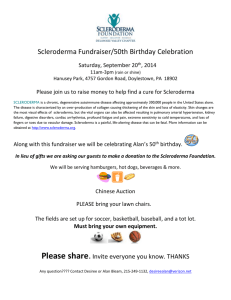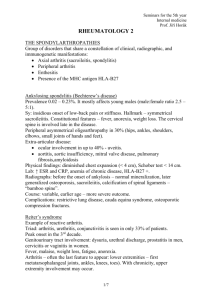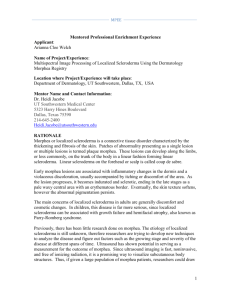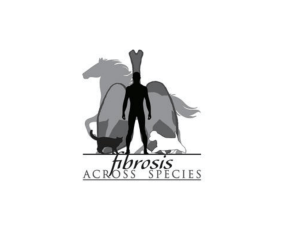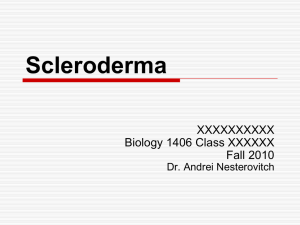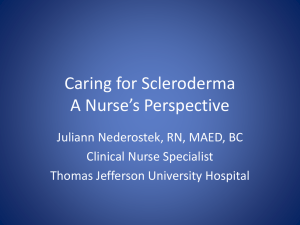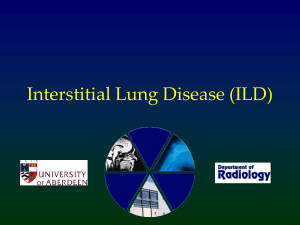Systemic_and_Localized_Scleroderm11-05-08
advertisement
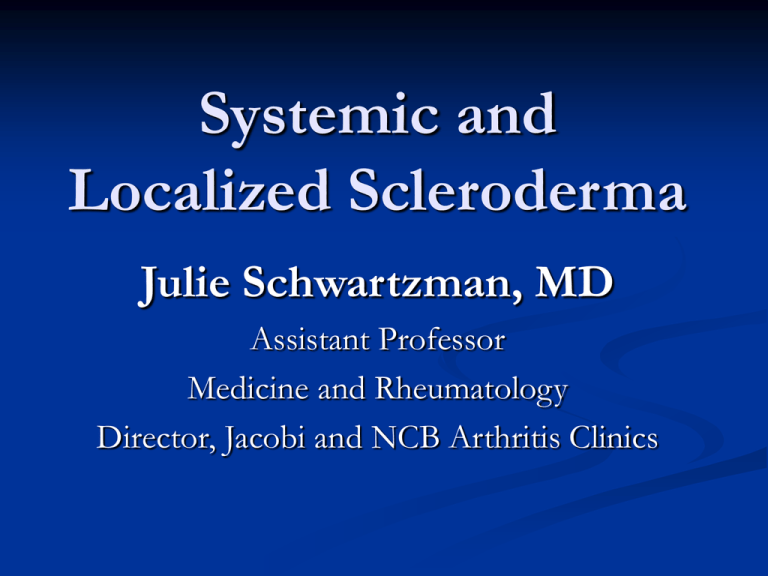
Systemic and Localized Scleroderma Julie Schwartzman, MD Assistant Professor Medicine and Rheumatology Director, Jacobi and NCB Arthritis Clinics Scleroderma: Systemic Sclerosis Chronic disease that causes skin thickening and tightening, and can involve fibrosis and other types of damage to internal body organs. Thought to be an autoimmune disease, affects both adults and children, most commonly adult women. While effective treatments are available for some manifestations of the disease, scleroderma is not yet curable. SSc Uncommon problem affecting only 200 to 300/million in the U.S. Traditional DMARDs have limited effect Increasingly, different aspects of scleroderma are becoming treatable. Research is shedding new light on the relationship between the immune system and scleroderma. CHARACTERIZED BY VASCULAR CHANGES, INTIMAL PROLIFERATION LEADING TO DEPOSITION OF COLLAGEN AND FIBROSIS. PRESENTATION AND PROGRESSION IS VARIABLE NO EFFECTIVE TREATMENT “Scleroderma” = more than one syndrome Localized scleroderma or morphea: confined to the skin and subcutaneous structures Systemic sclerosis: more uniform skin involvement and the potential for involvment of multiple visceral organs Multiple clinical variants Limited, Diffuse, Overlap Syndrome CREST: variant of Limited SSc Localized Scleroderma Each of the several forms of localized scleroderma is a disorder of skin and sometimes the deeper tissues. The most visible effects of the disease are skin lesions referred to as morphea. Morphea can be differentiated from SSc by the distribution of lesions (no sclerodactyly or perioral involvement), absence of Raynaud’s and/or periungual telangiectasia, and rarity of severe systemic disease Age of diagnosis usually 20-40, linear disease <18yrs, deep morphea mean age 46 Morphea The typical morphea lesion begins as a patch of erythema or edema that may have an associated violaceous border (inflammatory stage). Primary lesions=hyperpigmented patches. Become progressively indurated, porcelain white or yellow hue. Upon resolution, atrophy, depigmentation, or hyperpigmentation may occur. Plaque morphea Involves dermis and, occasionally, the superficial panniculus. Trunk is generally more commonly involved than the extremities, although the face, neck, or scalp can be involved. Plaque morphea comprises more than 50% of cases. Guttate morphea: This subset usually occurs on the upper trunk. Typically, it presents as multiple oval lesions between 2-10 mm in diameter. The lesions often manifest as faint erythema, followed by mild induration and hypopigmentation or hyperpigmentation. Keloid morphea: This presents as nodules that resemble keloids in the presence of typical morphea. Lichen sclerosus et atrophicus: shiny, white plaques often preceded by violaceous discoloration of the skin; predilection for the anogenital area. There is higher incidence of autoimmune-related diseases (eg, vitiligo, alopecia areata). Atrophoderma of Pasini and Pierini: asymptomatic, hyperpigmented atrophic patches with well demarcated "cliff drop borders" on the trunk. There are no pronounced inflammatory or sclerotic changes. The course is chronic, with spontaneous resolution usually after 10 years. Localized scleroderma including deep and extensive lesions can prevent normal motion of joints and interfere with daily activities. However, localized scleroderma does not affect internal organs of the body. Generalized morphea Generalized morphea or linear scleroderma: widespread lesions; thickness and scarring spreads down to the underlying structures including fat, muscle and, on rare occasion, bone. Disease can be more serious. Individual plaques of morphea become confluent lesions. It can affect more than 2 anatomic sites, including the upper trunk, breasts, abdomen, and upper thighs. Arms, legs, face, neck, and scalp also may be involved. Bullae may develop in localized areas, particularly around the abdomen. Keratoses and calcinosis may occur. Contractures may occur in limbs, and mobility may be restricted. Linear scleroderma One or more linear streaks and induration that can involve dermis, subcutaneous tissue, muscle, and bone. It occurs on the extremities, face, or scalp of children and adolescents. Linear scleroderma: discrete linear induration that primarily affects the extremities. In more than 90% involvement is unilateral. Complicated by deformities, joint contractures, and severe limb atrophy. Can affect the growth of bony structures. Linear Scleroderma Lesions en coup de sabre: If the face or scalp is affected with linear scleroderma, the involvement is often compared to a stroke from a sword (sabre). Lesions start with contractions and firmness of the skin over the affected area. Then, an ivory, irregular, sclerotic plaque with hyperpigmentation at the edge will develop. Progressive hemifacial atrophy (ParryRomberg syndrome): results in hemiatrophy of the face. The primary lesions occur in the subcutaneous tissue, muscle, and bone. The disease usually begins in the first 2 decades of life. Deep morphea: deep dermis, subcutaneous tissue, fascia, or superficial muscle. Lesions more diffuse than in linear scleroderma Subcutaneous morphea: panniculus or subcutaneous tissue. The onset is rapid, occurring during a period of several months. More inflammatory condition than other types. Morphea profunda: entire skin feels thickened, bound down, and taut. Patients develop deep sclerosis of the skin. Patients younger than 14 years. The extensor aspect of the extremities and trunk develops sclerotic plaques that extend deep into the subcutaneous tissue, fascia, muscle, and bone.. Deep morphea: deep dermis, subcutaneous tissue, fascia, or superficial muscle Disabling pansclerotic morphea of childhood: aggressive and mutilating generalized, full-thickness involvement of the trunk, extremities, face, and scalp. Fingertips and toes usually are spared. Eosinophilic fasciitis: painful peau d'orange appearance involving the extremities, proximal to the hands and feet. The fascia is the predominant level of involvement. Patients seem to spontaneously regress or remain unchanged for years. The diagnosis of morphea is based on clinical findings, although histopathologic confirmation is often needed to exclude other disorders Eosinophilia can be seen in generalized and linear scleroderma and often correlates with extent of disease. Polyclonal hypergammaglobulinemia can occur in 50% of patients with linear scleroderma Autoantibodies? Most titers correlate with the burden of skin disease antinuclear antibodies (46%-80%) anti–single-stranded DNA antibodies (50%) antihistone antibodies (47%). The presence of rheumatoid factor (60% of cases) may predict articular involvment Although anticentromere antibodies have been detected in up to 12% of patients with morphea, anti-topoisomerase I antibodies have only been reported in a handful of cases. Progression to SSc is rare (0.9%-5.7% of cohorts) Despite this, certain extra-cutaneous manifestations can occur. Arthralgias commonly occur, then resolve with progression of skin disease. Other findings: synovitis, uveitis, congenital vertebral abnormalities (especially spina bifida), cardiomyopathies, fever, and lymphadenopathy. Raynaud’s and carpal tunnel syndrome can develop as a secondary result of extensive extremity fibrosis. Morphea rarely coexists with other systemic autoimmune disorders, including dermatomyositis, polymyositis, systemic lupus erythematosus, primary biliary cirrhosis, rheumatoid arthritis, and MCTD Lesions typically regress spontaneously over 3 to 5 years, usually with residual pigmentary and atrophic changes. Although the few controlled trials did not show efficacy compared with placebo several therapeutic options are available particularly for patients with evidence of inflammatory changes and/or progressive lesions Systemic Sclerosis Diffuse systemic sclerosis: can affect the skin over almost any body area. Fibrosis proximal to elbows, knees. Rapid onset of disease following appearance of Raynauds More likely to have pulm fibrosis, GI, renal, cardiac ANA, Scl-70 Variable but overall poor prognosis, survival 40-60% at 10 years Systemic Sclerosis Limited systemic sclerosis: skin involvement is limited to forearms, hands, legs, feet, and face. Pts usually have Raynauds for years. Late visceral disease w/ prominent HTN and digital amputation CREST subgroup Anti-centromere Ab Relatively good prognosis, >70% survival at 10 years Overlap Syndromes Diffuse or limited SSc with one or more features of another CTD MCTD: features of SLE, SSc, PM, RA and presence of antiU1 RNP SSc Pathologic remodeling of connective tissues Cardinal features: excessive collagen production and deposition, vascular damage, and inflammation/autoimmunity. Widespread small-vessel vasculopathy and fibrosis in the setting of immune system activation Vascular injury affects small arteries, arterioles, capillaries The pathogenesis is initiated by microvascular injury (i). This induces inflammation and autoimmunity (ii), which have direct and indirect roles in inducing fibroblast activation (iii), a key event in the development of fibrosis. The number of fibroblasts and their precursors in affected tissues is increased by trafficking as well as by the differentiation of mesenchymal cells (iv). Activated myofibroblasts in the lesional tissue perform a series of functions culminating in fibrosis (v). MSC, mesenchymal stem cell. Transforming growth factor–b Stimulates cell growth, apoptosis, and differentiation Promotes collagen and matrix protein production Decreases the synthesis of collagen-degrading metalloproteinases Stimulates fibroblasts to maintain an activated state. Stimulates CTGF synthesis in fibroblasts, vascular smooth muscles,and endothelial cells. CTGF can trigger angiogenesis, apoptosis, chemotaxis, extracellular matrix formation, and the structural organization of connective tissues. Non–TGFb–related pathways that involve the activities of p38 kinase,C-delta kinase, and phosphatidylcholine phospholipase C kinase may also play a role Genetics likely predisposes patients to the disease, but whether scleroderma is the result of some combination of genetic factors and other exposures is unknown. Some data suggests that exposure to industrial solvents or an environmental agent may play a role in predisposing to scleroderma. Scleroderma-like syndromes also have been clearly linked to agents as varied as contaminated rapeseed oil, polyvinylchloride, and a contaminant in one preparation of L-tryptophan. Majority of patients with scleroderma do not have a history of exposure to any suspicious toxins. Who gets scleroderma Relatively rare, affecting only 75,000 – 100,000 people in the United States. 75% percent are women usually diagnosed between the ages of 30 and 50 years. Twins and family members of patients with scleroderma or other autoimmune CTD appear to be at a slightly increased risk. Children can get scleroderma, although the pattern and extent of disease may be different in children. Who gets scleroderma Ethnicity influences severity and survival Progressive IPF less frequent and w/ better survival rates in Caucasians Caucasians: inc rate of anti-centromere Ab African Americans: inc rate Scl 70 Inc presence of parvovirus B19 in BM Occupational exposure to silica: RR 25, silicosis RR 110 Clinical Features: Cutaneous Thickened skin: abnl production of type 1 collagen by fibroblasts, accumulation of GAG and fibronectin in ECM. Begins in fingers and hands Calcinosis: deposits of basic CaPhos Telangiectasias: dilated sm v. More common in LSSc Can bleed when in GI mucosa SYSTEMIC SCLEROSIS CREST VARIANT CALCINOSIS RAYNAUD’S ESOPHOGEAL DYSFUNCTION SCLERODACTALY TELANGECTASIA Clinical Features – Raynaud’s Almost all (more than 90%) of people with scleroderma also have Raynaud's phenomenon. Raynauds Triphase event affecting the hands and feet, the nose, the ears, and the tongue Characterized by abrupt pallor (white), followed by cyanosis (blue), and sometimes, painful erythema secondary to restoration of blood flow. The succession of phases is linked to 3 pathogenic mechanisms— vasoconstriction, ischemia, and reperfusion. Small areas of fingertip ischemic necrosis are frequent, often leaving pitted scars or ulcerations. On microscopic examination in Raynaud’s of some duration, the capillary circulation is altered by the appearance of tortuous and dilated or giant loops and, in dcSSc, by a paucity of nailfold vessels or dropout Primary Raynauds FEMALE PREDOMINENCE ONSET AT MENARCHE ALL DIGITS INVOLVED MULTIPLE ATTACKS DAILY EMOTIONAL AND COLD NO ISCHEMIC ULCERS NORMAL NAIL BED CAPILLARIES NO SYSTEMIC SYMPTOMS NORMAL SEROLOGY Secondary Raynauds LATER ONSET MAY INVOLVE ONLY A FEW DIGITS EMOTION IS LESS OF A TRIGGER ISCHEMIC ULCERS MAY BE PRESENT EDEMA MAY BE PRESENT PERIUNGUAL CAPILLARIES MAY BE ABNORMAL SYSTEMIC FEATURES ANA Pt with Raynauds may progress to SSc if: +ANA, anti-centromere, anti-Scl-70 Nailfold capillary abnl, dropout or dilatation Tendon friction rubs Puffy swollen fingers Associated GERD If Raynauds preceeds skin changes by >1 yr, likely Limited SSc If Raynauds and skin changes occur at same time, likely dSSc TREATMENT OF RAYNAUD’S NON-PHARMACOLOGIC – LIFESTYLE ASJUSTMENTS TO PRECIPITANTS: STOP SMOKING, AVOIDANCE OF b-BLOCKERS, EXERCISE, KEEP WARM ORAL VASODILATOR DRUGS: CALCIUM CHANNEL BLOCKERS, ACE INHIBITORS/ANGIOTENSION RECEPTOR ANTAGONISTS, TOPICAL NITROGLYCERINE, PROSTACYCIN (IV) IF AVAILABLE DIGITAL SYMPATHECTOMY PROMPT TREATMENT OF FINGERTIP ULCERATIONSANTIBIOTICS AND DEBRIDEMENT GI- 2nd most commonly affected organ system 75-90% patients Lower Esoph Dysmotility: smooth muscle fibrosis, esophageal dysfunction in 80% pts- GERD, fibrosis and stricture formation, aspiration PNA Gastroparesis, telangiectases, watermelon stomach SI: malabsorption and diarrhea secondary to bacterial overgrowth, functional ileus from musclar fibrosis w/ hypomotility and dilatation Colorectal: severe constipation, megacolon, wide mouth diverticula GI MANAFESTATIONS Downloaded from: Rheumatology (on 31 July 2005 04:16 AM) © 2005 Elsevier Treatment - GI Elevation of the head of the bed at night and appropriate diet plus the use of H2 blockers and/or proton pump inhibitors. Metoclopramide and erythromycin are prokinetic drugs that can be used to promote GI motility, particularly of the upper GI. Esophageal stricture requires periodic endoscopic dilatation. The bleeding telangiectasias and ecstatic superficial vessels of watermelon stomach can be treated with sclerotherapy and laser coagulation, respectively. In the lower GI tract, symptoms related to bacterial overgrowth may improve with 2- to 4week courses of broad-spectrum antibiotics Octreotide, given subcutaneously, is moderately effective as a prokinetic agent for lower GI symptoms. Rarely, TPN will be needed in patients whose small intestine is essentially nonfunctional. SYSTEMIC SCLEROSIS PULMONARY DISEASE INTERSTIAL FIBROSIS PULMONARY HYPERTENSION ASPIRATION PNEUMONIA PLEURAL DISEASE NEOPLASM Most common initial respiratory sx is DOE, w/o cough or chest pain Pulmonary Pulmonary manifestations of SSc occur in more than 70% of patients. Most common SSc-related cause of death. Pulmonary fibrosis is a common cause of severe restrictive lung disease CXR shows interstitial thickening in a reticular pattern of linear, nodular densities most easily seen in the lower lung fields. Pulmonary High-resolution CT more sensitive for detecting interstitial lung disease Abnormal findings: ground-glass appearance possibly associated with inflammation/alveolitis, bronchiectasis and/or honeycombing (associated with fibrosis). Alveolitis can be documented by either broncho-alveolar lavage or open lung biopsy Pulmonary Restrictive lung disease on PFTs used as a marker for pulmonary fibrosis. In a somewhat later disease, the presence of bibasilar rales on physical examination is found. Some patients with interstitial lung disease develop slowly progressive respiratory failure over the course of 2 to 10 years, especially those with anti-topoisomerase I antibody. In Diffuse SSc, ILD more common In Limited SSc P HTN more common PAH Pulmonary hypertension is more common than previously thought (up to 30% of patients) and can occur early. Signs of pulmonary arterial hypertension (PAH) occur in approximately 10% to 15% patients with SSc but may be found on echocardiogram or right heart catheterization in 20% to 40% of patients. There are 3 patterns of PAH: severe isolated PAH without significant interstitial fibrosis, which occurs predominantly in patients with lcSSc after 10 to 30 years; PAH complicating interstitial pulmonary fibrosis, which occurs predominantly in dcSSc patients Third type of pulmonary vascular disease reflects the combined vascular and fibrotic pathologic processes of the disease and results in a more indolent pulmonary process. Found in those patients who have very slow progressive PAH and who have a secondary pulmonary vascular component in the context of relatively mild fibrosis, distinct from the severe interstitial process seen in true secondary PAH. Symptomatically, patients will present with progressive dyspnea but, in late PAH, may present with syncopy. The pulmonic component of the second heart sound is accentuated, and ultimately, right-sided cardiac failure develops. The diffusing capacity for carbon monoxide is very low relative to the forced vital capacity, consistent with impaired gas exchange across thickened small pulmonary blood vessels. Diagnosis is confirmed by echocardiogram or by right heart catheterization. Treatment Prophylactic influenza and Streptococcus pneumoniae vaccinations In persons with alveolitis, immunosuppressive drugs, cyclophosphamide and azathioprine, may be effective. In intrinsic PAH intermittent and continuous intravenous prostacyclin analogs; the endothelin-1 antagonist, bosentan; and the phosphodiesterase type 5 inhibitor, sildenafil have been approved. Anticoagulation is often prescribed. Heart-lung or single lung transplantation is an option for end-stage lung disease Renal Kidney involvement in SSc may be manifested by scleroderma renal crisis (SRC). Scleroderma renal crisis used to be the most severe complication in scleroderma and the most frequent cause of the death in these patients. Renal Over the last 20 to 25 years, ACE-I have dramatically improved SRC outcome. Although death and dialysis within 6 weeks were common before the advent of aggressive ACE inhibitor use, 60% of patients with SRC no longer require dialysis or require only temporary dialysis. Clinically evident renal involvement is almost exclusive to persons with dcSSc, especially those with rapidly progressive skin thickening than 5 years in duration. Renal Crisis Scleroderma renal crisis develops in about 18% of pts with dcSSC Abrupt onset of accelerated hypertension, followed by oliguric renal failure. Sx: headache and visual blurring from hypertensive retinopathy, seizures, and acute dyspnea due to sudden left ventricular failure. Renal Crisis Microscopic hematuria and low-grade proteinuria within several days or weeks along with rapidly increasing serum Cr, oliguria or anuria. Risks: diffuse skin disease, new unexplained anemia, use of steroids, pregnancy, and anti-RNA polymerase III Ab Poorer outcome in males, older, Cr >3 mg/dl Microangiopathic hemolytic anemia with thrombocytopenia frequently occurs Non renal crisis abnormalities: Mild proteinuria, mild elevation in the plasma creatinine concentration, and/or hypertension are observed in as many as 50% of patients. Impaired renal reserve may be present in patients in the absence of clinical renal disease. Clinically evident disease is less common, but autopsy studies suggest that 60% to 80% of patients with dcSSc have pathologic evidence of renal involvement Treatment Prompt detection is the most important aspect of therapy for renal crisis. Patients with early dcSSc are advised to take their blood pressure every several days to weekly and to report a rise of systolic pressure of 30 mm Hg or greater. ACE inhibitors are the drugs of choice, but early aggressive therapy with other potent antihypertensive agents can also be successful. Some patients may require dialysis, but most can be maintained on ACE inhibitors, and dialysis can be discontinued after 3 to 24 months. Successful renal transplants have been reported. Cardiac Primary cardiac involvement: myocardial fibrosis, LV or biventricular CHF, myocarditis, pericarditis with or without effusion, valvular abnormalities, or supraventricular or ventricular arrhythmias. Acute symptomatic pericarditis is unusual. Left sided congestive heart failure secondary to myocardial fibrosis occurs in fewer than 5% of dcSSc patients. Cardiac Cardiac arrhythmias include complete heart block and other EKG abnormalities. Valvular disease usually minor, not hemodynamically significant. Secondary cardiac disease occurs in association with SSc pulmonary or renal disease or in overlap with other illnesses such as systemic lupus erythematosus or polymyositis. Treatment Nonsteroidal anti-inflammatory drugs or low-dose corticosteroids can be used for symptomatic pericarditis. If myocarditis is identified clinically or by endomyocardial biopsy, high-dose glucocorticoid therapy should be tried. Digitalis and diuretics are the mainstay of therapy. The typical progressive left ventricular failure caused bymyocardial fibrosis is unaffected by any therapy and may lead to cardiac transplantation. Serious arrhythmias are treated in the standard way MSK Manifestations may include muscle weakness and rheumaticcomplaints ranging from simple arthralgias to frank arhtritis. In dcSSc, symptoms often start with symmetric polyarthralgia and joint stiffness (with or without gross synovitis), myalgia, and puffiness of the skin. Joint pain, immobility, and contractures are the result of fibrosis around tendons and other periarticular structures. Contractures of the hands from this process are most common, but large joint contractures involving the wrists, elbows, hips and ankles may also occur. MSK Some patients may have palpable and/or audible deep periarticular tendon friction rubs during motion; this may be due to fibrinous tenosynovitis. Severe arthritis or destructive joint disease should make one suspect an overlap syndrome with rheumatoid arthritis. 2 principal patterns of muscle involvement Scleroderma myopathy, frequently mild and relatively nonprogressive, p/w minor proximal weakness and slight to moderate elevations of CPK Sclerodermatomyositis, a true overlap between scleroderma and polymyositis Far less common. Weakness is often more profound, with significantly elevated CPK and EMG/muscle biopsy abnormalities typical for inflammatory myopathy. Neuro Neurologic involvement occurs in up to 40% of patients with SSc. Manifestations include cranial nerve abnormalities, peripheral nerve involvement, and autonomic neuropathy. Central nervous system involvement is usually secondary to SSc renal or cardiopulmonary involvement. Neuropathy can be asymptomatic or can be lifethreatening if autonomic nervous system is involved. Disease Modifying Treatments While some treatments have proven effective in treating the disorder, scleroderma is not yet curable. Much research has gone into addressing the various manifestations of the disease, but no drug has been found that can arrest or reverse the skin thickening that is the hallmark of disease. Treatments are disease modifying vs. symptomatic (by organ system affected) as presented DMARDs can be selected on basis of other coexisting conditions if there is disease overlap Suppression of autoimmunity and inflammation Cyclophosphamide: data NIH randomized, double-blind, placebo-controlled trial (The Scleroderma Lung Study) showed beneficial effects of cyclophosphamide over placebo in SSc patients with active alveolitis. Treatment had a modest effect on pulmonary function, a larger effect on pulmonary symptoms and a clear, and a statistically significant effect on skin in patients with diffuse skin involvement. MTX Chlorambucil 5-FU Stem cell transplant Since 1996, autologous peripheral blood stem cell (PBSC) transplantation used worldwide with a low early mortality of 5% Based on these data, intensive myelo- and immuno suppression followed by autologous hematopoietic stem cell transplantation (HSCT) has been used to treat severe SSC Since 1996, approx 1000 PBSC transplants for autoimmune diseases have been reported 140 SSc patients in the EBMT (European Group for Blood and Marrow Transplantation) and EULAR (European League Against Rheumatism) database as to March 2007. The early results from the phase I/II clinical trials showed that HSCT is feasible in carefully selected patients with diffuse SSc 2004 follow up report from the EBMT-EULAR database, consisting of different centers and treatment schemes, showed positive responses at 3 years in two thirds of 57 patients with an early treatment related mortality of 8.7% The specific aims of this study: evaluate the survival and the durability of responses up to 7 years of follow-up in SSc patients treated by autologous HSCT. Long-term follow up results of all the Dutch and French patients included in two similar phase I/II trials, using uniform eligibility criteria and a single transplantation protocol Patients and Methods All patients-ACR preliminary criteria for SSc and had the diffuse cutaneous form. Patients eligible if : (a) age < 66 years (b) rapidly progressive disease (2 years duration with a modified Rodnan skin score (mRSS) above 20, ESR > 25 mm/first h and/or Hb < 11 g/dL, not explained by other causes than active SSc Patients and Methods OR (c) a disease duration >2 years plus a progression of the mRSS (20%) plus major organ involvement related to SSc as defined by either: (1) lung involvement: with a vital capacity (VC) or DLCO below 70% predicted, or a mean pulmonary artery pressure (PAP) above 40 mmHg (measured by echocardiography); (2) digestive tract involvement: with serum albumin <25 g/L or weight loss exceeding 10% body weight in the preceding year; (3) kidney involvement: with 24-h urinary protein above 0.5 g or serum creatinine above 120 mmol/L. Exclusion Criteria Uncontrolled arrhythmia, left ventricular ejection fraction (LVEF) <50% or mean PAP >50 mmHg measured by ECHO DLCO <45% of predicted, creatinine clearance <20 ml/min Platelets <80 000/mm3, hemorrhagic cystitis, HIV or HTLV1 seropositivity, malignancy, pregnancy, a cardiac or vascular prosthesis, and no vascular access After a median follow-up of 5.2 (1–7.5) years, death from disease progression occurred in 2 patients (8%): both from relapse at 18 months after transplantation, one after initial PR and the other after initial MR. A third patient, a heavy smoker, died from small cell lung cancer 64 months after HSCT. Among the others showed 35% (n=9) sustained MR, 50% (n=13) sustained PR, and 3% (n=1) progressed after PR. Event-free survival (EFS) for the patients with at least 6 months of follow-up after autologous HSCT was 64.3% (95% CI 47.9– 86.3%) at 5 years and 57.1% (95% CI 39.3–83.1%) at 7 years Results The WHO performance status improved throughout the follow up, from baseline values at median 2.12 (0–4, n=26) to 0.60 (0– 2, n=15 p,0.05) after 5 years of follow-up (fig 2). A significant fall in mRSS was observed up to 7 years after HSCT with faster regression within the first year and sustained fall thereafter. In comparison with baseline values for all patients, there was no significant change in FEV1 or DLCO during follow-up. Cardiac and renal function remained stable during follow-up Benefits and Survival After a median follow-up of 5.3 (1–7.5) years 81% (n=21/26) of the patients demonstrated a clinically beneficial response. The Kaplan–Meier estimated survival at 5 years was 96.2% (95% CI 89–100%) and at 7 years 84.8% (95% CI 70.2–100%) and event-free survival, defined as survival without mortality, relapse or progression of SSc, resulting in major organ dysfunction was 64.3% (95% CI 47.9–86%) at 5 years and 57.1% (95% CI 39.3– 83%) at 7 years. The positive effect of HSCT on survival rate needs to be interpreted with care, due to a wide range in the duration of patients’ follow-up and the uncontrolled nature of this study, but the results are encouraging. Agents to inhibit fibrosis Gamma interferons Interferon alpha D-penicillamine Relaxin Prevention of vascular damage Prostacyclin analoge: poprostenol and treprostinil, benefit exercise capacity, dyspnea score, cardiopulmonary hemodynamics, and survival. The inhaled form of Iloprost, another prostacyclin derivative, is also available in the United States. Data supporting the use of Iloprost in SSc PAH are mostly symptomatic Bosentan: oral mixed endothelin A/B antagonist, which improves PAH because it antagonizes endothelin-1, a potent vasoconstrictor and smooth muscle mitogen. Two randomized, placebo-controlled studies have shown that bosentan improves exercise capacity, cardiopulmonary hemodynamics, decreased pulmonary vascular resistance, and decrease pulmonary artery pressure. Prevention of vascular damage Sildenafil: phosphodiesterase-5 inhibitor causes preferential pulmonary vasodilation, decreases pulmonary vascular resistance index, and improves gas exchange in patients with severe lung fibrosis and secondary pulmonary hypertension ACE-I: despite rising serum creatinine concentrations while taking an ACE inhibitor, the drug should be continued as part of the antihypertensive therapy. These treatments, and those being tested in current research trials, may provide significant benefit to patients with lung disease in scleroderma. The basic process of fibrosis awaits proven effective therapy. Case Report 65-yr-old Korean female visited the Rheumatology Clinic due to the thickening of hand and facial skin with digital pallor and cyanosis on cold exposure x 2 mo. On the first visit, BP 130/80 mmHg PE: skin thickening on the fingers of both hands, and on the right hand dorsum and right forearm. She was diagnosed with systemic sclerosis of the limited cutaneous subset J Korean Med Sci. 2006 Dec;21(6):1121-1123. A Case of Renal Crisis in a Korean Scleroderma Patient with Anti-RNA polymerase I and III Antibodies WBC 8.39×109/L, Hgb 12.1 g/dL, platelets 240×109/L ESR 8 mm/hr, ALT 21U/L, AST 18 U/L, total bilirubin 0.6 mg/dL, albumin 3.7 g/dL, BUN 11 mg/dL, and creatinine 0.7 mg/dL. ANA+, but anti-centromere and anti-SCL-7- negative. PFTs: FVC 73%; forced expiratory volume in 1 sec, 79%; and DLCO 121%. High resolution CT of the lungs revealed old TB in the right lower lobe with pleural thickening and calcifications without evidence of interstitial lung disease. Prazosin 1 mg/day was administered for Raynaud's phenomenon and intermittent antihistamines for skin pruritus. Twenty- two months after the diagnosis of limited SSc, her skin thickening began to rapidly progress above elbows and knees, and finally involved the trunk. Blood pressure was in the normal range. The diagnosis was converted to SSc of the diffuse cutaneous subset and she was started on D-penicillamine 250 mg/day. A month later, she visited the emergency room due to the sudden onset of facial edema and severe dyspnea. Her blood pressure was 220/134 mmHg, heart rate 120 beats/ min, respiration rate 48/min, and body temperature 35℃. She reported that the dyspnea had begun 10 days previously and that her urine output had decreased markedly. A physical examination revealed facial and pre-tibial edema, and pulmonary rales in the whole lung field. Laboratory data showed hemoglobin at 9.9 g/dL, LDH 703 IU/L, total bilirubin 2.9 mg/dL, indirect bilirubin 1.8 mg/dL, and schistocytes with polychromasia on peripheral blood smear, suggesting intravascular hemolysis. Antineutrophil cytoplasmic antibody was negative. Urinalysis and microscopic examination showed mild proteinura (1+), hematuria (≥100 RBC per high power field with dysmorphic RBC >90%), and pyuria (20-29 white blood cells per high power field). Urine culture grew no organisms. Azotemia was also detected with a BUN of 31 mg/dL and a creatinine of 2.2 mg/dL. CXR: cardiomegaly and bilateral hilar infiltrates consistent with pulmonary edema. She was transferred to intensive care unit, intubated, and assisted with a mechanical ventilator. Under a diagnosis of scleroderma renal crisis, captopril was begun, but failed to reverse a deteriorating renal function despite successful blood pressure control within 2 days. Renal biopsy showed severe fibrinoid necrosis with luminal obliteration in interlobar arteries and arterioles, strongly suggesting scleroderma renal crisis Immunofluorescence staining showed no evidence of immune complex or autoantibody deposition. Because scleroderma renal crisis has been reported to be associated with anti-RNAP I or III antibodies, pt was tested and, anti-RNAP I/III antibodies were detected Hemodialysis was started and has been continued for 3 yr without renal recovery.
